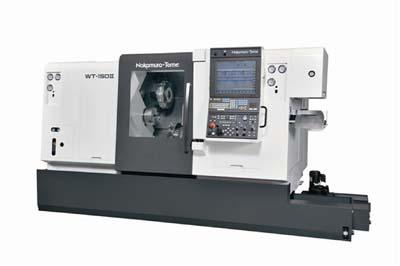
Methods Machine Tools Inc. has introduced the Nakamura-Tome WT-150 II 8-Axis, Multitasking Turning Center. The WT-150 II, which features numerous upgrades from the base WT-150 design, has opposed twin-spindle, 2-turret construction, offering high-speed and high rigidity in a compact machine.
"With the introduction of the WT-150 II, we are able to offer simplified operations and greater efficiency and speed on a powerful multitasking Nakamura machine," said Richard Parenteau, Director of Application Development at Methods Machine Tools.
For ease-of-operation, the WT-150 II features a 19" high-resolution, touch screen LCD panel. A FANUC 31i-B CNC control and a PC-based control (NT-IPS) provides a high-speed programmable machine controller for faster processing and several features for increased efficiency and maintainability. New standard functions include a spindle speed override switch, a program number search, C-axis synchronization and helical interpolation (for Y-axis models).
In addition, the distance between the spindles has been increased to 31.5" (800mm) while still providing the same compact machine footprint of 67.8 ft2; x 6.2 ft (6.3m2; x 1.9m). Also, with a maximum tool swing of 23" (570mm) on the upper and lower turrets, users can drill through a 2" (51mm) bar diameter from one side on the Nakamura WT-150 II.
The spindle motor features increased torque for greater speed, and the S3 rate is now available for high torque. Faster feed is provided via a rapid traverse of 787 ipm on the X-axis, and cutting feeds of 314 ipm on the X, Z, and B axes. With simultaneous 4+4 axis control, the WT-150 II offers 8-axis machining capability.
The system includes 12 station upper and lower turrets with a half-index capability, to hold a total of 48 tools for multiple processes. A left and right spindle with speeds up to 5,000 RPM at 20 / 15 HP, and a 6 inch (150mm) chuck and 2 inch (51mm) bar capacity are provided. The WT-150 II is capable of 7.5 HP milling capacity on the C-axis.
The WT-150 II features the latest Nakamura cover design with a large window, LED work light for maximum visibility and a lightweight door with maintenance equipment conveniently available in an arrangement at the front of the machine. CAMplete TruePath Turn/Mill software is standard on Nakamura-Tome Multitasking Turning Centers. CAMplete Turn/Mill software is an integrated suite of G-Code editing, optimization, analysis and verification tools, enabling a full range of turn/mill functions.
Contact Details
Related Glossary Terms
- centers
centers
Cone-shaped pins that support a workpiece by one or two ends during machining. The centers fit into holes drilled in the workpiece ends. Centers that turn with the workpiece are called “live” centers; those that do not are called “dead” centers.
- chuck
chuck
Workholding device that affixes to a mill, lathe or drill-press spindle. It holds a tool or workpiece by one end, allowing it to be rotated. May also be fitted to the machine table to hold a workpiece. Two or more adjustable jaws actually hold the tool or part. May be actuated manually, pneumatically, hydraulically or electrically. See collet.
- computer numerical control ( CNC)
computer numerical control ( CNC)
Microprocessor-based controller dedicated to a machine tool that permits the creation or modification of parts. Programmed numerical control activates the machine’s servos and spindle drives and controls the various machining operations. See DNC, direct numerical control; NC, numerical control.
- feed
feed
Rate of change of position of the tool as a whole, relative to the workpiece while cutting.
- gang cutting ( milling)
gang cutting ( milling)
Machining with several cutters mounted on a single arbor, generally for simultaneous cutting.
- inches per minute ( ipm)
inches per minute ( ipm)
Value that refers to how far the workpiece or cutter advances linearly in 1 minute, defined as: ipm = ipt 5 number of effective teeth 5 rpm. Also known as the table feed or machine feed.
- interpolation
interpolation
Process of generating a sufficient number of positioning commands for the servomotors driving the machine tool so the path of the tool closely approximates the ideal path. See CNC, computer numerical control; NC, numerical control.
- milling
milling
Machining operation in which metal or other material is removed by applying power to a rotating cutter. In vertical milling, the cutting tool is mounted vertically on the spindle. In horizontal milling, the cutting tool is mounted horizontally, either directly on the spindle or on an arbor. Horizontal milling is further broken down into conventional milling, where the cutter rotates opposite the direction of feed, or “up” into the workpiece; and climb milling, where the cutter rotates in the direction of feed, or “down” into the workpiece. Milling operations include plane or surface milling, endmilling, facemilling, angle milling, form milling and profiling.
- rapid traverse
rapid traverse
Movement on a CNC mill or lathe that is from point to point at full speed but, usually, without linear interpolation.
- turning
turning
Workpiece is held in a chuck, mounted on a face plate or secured between centers and rotated while a cutting tool, normally a single-point tool, is fed into it along its periphery or across its end or face. Takes the form of straight turning (cutting along the periphery of the workpiece); taper turning (creating a taper); step turning (turning different-size diameters on the same work); chamfering (beveling an edge or shoulder); facing (cutting on an end); turning threads (usually external but can be internal); roughing (high-volume metal removal); and finishing (final light cuts). Performed on lathes, turning centers, chucking machines, automatic screw machines and similar machines.

